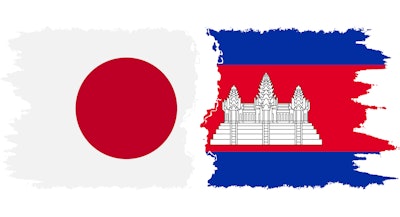
Following a six-month hiatus, first cases of highly pathogenic avian influenza (HPAI) have been detected in the Japanese poultry sector.
Confirmed so far are two farm outbreaks — the first on the island of Kyushu in the far southwest of the country, and the second in the Greater Tokyo area in eastern Honshu. At both locations, presence of the H5N1 virus serotype was confirmed by the agriculture ministry over the past week.
Both outbreaks involved commercial egg laying flocks, according to the official notification to the World Organisation for Animal Health (WOAH). Suspicions were raised after a spike in bird mortality.
First to be affected was a farm with more than 38,000 hens in the Kashima city area, which is part of Saga prefecture on Kyushu. Two days later, some of the 72,000 birds at a farm near Kasama city in Ibaraki prefecture tested positive for the virus after 400 died.
These are the first outbreaks of the new HPAI season in Japan.
In 2022, outbreaks linked to the same virus serotype began on the northernmost island of Hokkaido at the end of October, according to Japan Times. By the end of the outbreak wave in June of this year, cases had been detected in poultry in 26 prefectures. To control the spread, 17.71 million poultry were culled, which led to an egg shortage in the country, as well as record retail prices.
Of the 83 outbreaks in Japan reported to WOAH over the 2022-2023 season, more than 60 involved laying hens.
Since early October, wild birds in Japan have tested positive for the same virus serotype. So far, WOAH has been notified of 19 cases found widely across the country from the northernmost main island of Hokkaido to Kyushu.
Two-year HPAI hiatus ends in Cambodia
Also officially reporting new HPAI outbreaks in poultry linked to the H5N1 virus variant to WOAH has been the Cambodian veterinary authority.
In early October, first cases were detected in a village flock in Svay Rieng province in the southeast of the country. Of the 334 birds in the flock, 199 died. Just one day later, almost 80% of a similar flock of 1,486 poultry died in the neighboring province of Prey Veng. The outbreaks appear to be within 20km of each other.
These were the first cases of HPAI in the country’s poultry since January of 2021, according to the WOAH notification.
In recent days, the same virus has been detected in the southeastern province of Kampot. Affected were backyard flocks in a village in Dang Tong district. Of the 322 poultry affected, just over 100 died.
HPAI outbreaks elsewhere in Asia
Over the past month, the animal health agency of Taiwan has confirmed two further HPAI outbreaks in poultry to WOAH.
Affected were two farms in early October, again involving the H5N1 virus serotype. The first comprised around 19,000 birds in Tainan city, while the second was in Chiayi county with more than 50,000 poultry of unspecified type.
These were the last two outbreaks in an outbreak series that began in November of 2022. Cases were detected at 62 locations including farms and slaughterhouses, directly impacting almost 1.24 million poultry.
Across the Asian continent in Israel, one wild bird tested positive for the same virus variant in early November. It was a water bird found in the Center District (Hamerkaz), according to the WOAH notification.
This brings to three the number of outbreaks in the country since September. The earlier outbreaks involved a wild bird and a zoo in the North District (Hazafon).
More human cases in Cambodia, China
In Cambodia, two more people have contracted infections of the avian influenza A(H5N1) virus, according to the Centre of Health Protection, which is part of the government of Hong Kong.
Last week, the Center recorded two cases — a 21-year-old woman, and a four-year-old girl — who required hospital admission. Both were from the Dang Tong district of Kampot province — the same area as the recently reported outbreaks in village poultry.
Together with two cases confirmed last month, these bring the total cases of this infection in Cambodia so far this year to six.
Over the past month, the World Health Organization (WHO) has been informed by the relevant Chinese agency about one further infection with the avian influenza A(H9N2) virus.
Onset of symptoms was in early October in a patient in Guang’an city in Sichuan province. This brings the total cases linked to this virus in the Western Pacific Region and notified to WHO since 2015 to 92. Of these, 90 infections have occurred in China, and the other two in Cambodia.
View our continuing coverage of the global avian influenza situation.

















